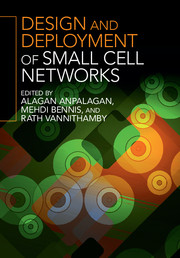Book contents
- Frontmatter
- Contents
- List of contributors
- Preface
- 1 Mobility performance optimization for 3GPP LTE HetNets
- 2 Design and performance analysis of multi-radio small cell networks
- 3 Dynamic TDD small cell management
- 4 3GPP RAN standards for small cells
- 5 Dense networks of small cells
- 6 Traffic offloading scenarios for heterogeneous networks
- 7 Required number of small cell access points in heterogeneous wireless networks
- 8 Small cell deployments: system scenarios, performance, and analysis
- 9 Temporary cognitive small cell networks for rapid and emergency deployments
- 10 Long-term evolution (LTE) and LTE-Advanced activities in small cell networks
- 11 Game theory and learning techniques for self-organization in small cell networks
- 12 Energy efficient strategies with BS sleep mode in green small cell networks
- 13 Mobility management in small cell heterogeneous networks
- 14 The art of deploying small cells: field trial experiments, system design, performance prediction, and deployment feasibility
- 15 Centralized self-optimization of interference management in LTE-A HetNets
- 16 Self-organized ICIC for SCN
- 17 Large-scale deployment and scalability
- 18 Energy efficient heterogeneous networks
- 19 Time- and frequency-domain e-ICIC with single- and multi-flow carrier aggregation in HetNets
- Index
- References
10 - Long-term evolution (LTE) and LTE-Advanced activities in small cell networks
Published online by Cambridge University Press: 05 December 2015
- Frontmatter
- Contents
- List of contributors
- Preface
- 1 Mobility performance optimization for 3GPP LTE HetNets
- 2 Design and performance analysis of multi-radio small cell networks
- 3 Dynamic TDD small cell management
- 4 3GPP RAN standards for small cells
- 5 Dense networks of small cells
- 6 Traffic offloading scenarios for heterogeneous networks
- 7 Required number of small cell access points in heterogeneous wireless networks
- 8 Small cell deployments: system scenarios, performance, and analysis
- 9 Temporary cognitive small cell networks for rapid and emergency deployments
- 10 Long-term evolution (LTE) and LTE-Advanced activities in small cell networks
- 11 Game theory and learning techniques for self-organization in small cell networks
- 12 Energy efficient strategies with BS sleep mode in green small cell networks
- 13 Mobility management in small cell heterogeneous networks
- 14 The art of deploying small cells: field trial experiments, system design, performance prediction, and deployment feasibility
- 15 Centralized self-optimization of interference management in LTE-A HetNets
- 16 Self-organized ICIC for SCN
- 17 Large-scale deployment and scalability
- 18 Energy efficient heterogeneous networks
- 19 Time- and frequency-domain e-ICIC with single- and multi-flow carrier aggregation in HetNets
- Index
- References
Summary
Introduction
The general definition of a small cell is the low-powered radio access node operating in licensed and unlicensed spectrum with the smaller coverage of ten meters to one or two kilometers, compared to a mobile macro cell with a range of a few tens of kilometers. With the introduction of this new concept, the heterogeneous network (HetNet) constructed with different layers of small cells and large cells can deliver the increased bandwidths, reduced latencies, and higher uplink (UL) and downlink (DL) throughput to end users. Since 2009, the standard evolution of the small cell related topics has been studied in 3GPP (The 3rd Generation Partnership Project) LTE (long-term evolution) and LTE-Advanced. The following sections in this chapter will introduce the standardization progress of LTE and LTE-Advanced in small cells.
Definition of small cells in 3GPP LTE-Advanced
In 3GPP LTE and LTE-Advanced, small cells can generally be characterized as either relay nodes, or pico cells (also referred to as hotzone cells), controlled by a pico eNodeB, or femto cells, controlled by a Home evolved NodeB (HeNB). The common features among the relays, pico cells, and femto cells are low transmission power node and independent eNB functionality, while the typical different features can be summarized as follows:
1. Relay node [1, 2]. A relay node (RN) is a network node connected wirelessly to a source eNodeB, called the donor eNodeB. According to the different implementation types of the relay node into wireless network, the roles of the relay node played are also different.
2. Pico cell. A pico cell usually controls multiple small cells, which are planned by:
a. The 3rd Generation Partnership Project (3GPP), which unites six telecommuni-cations standard development organizations (ARIB, ATIS, CCSA, ETSI, TTA, and TTC), known as organizational partners, and provides their members with a stable environment to produce the highly successful reports and specifications that define 3GPP technologies.
b. The evolved Node B could be abbreviated as eNodeB or eNB by the network operator in a similar way as the macro cells [3]. The pico cell is usually open to all users (open subscriber group (OSG))[4].
- Type
- Chapter
- Information
- Design and Deployment of Small Cell Networks , pp. 213 - 241Publisher: Cambridge University PressPrint publication year: 2015



